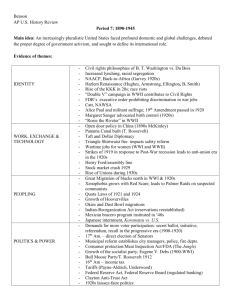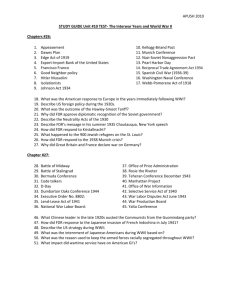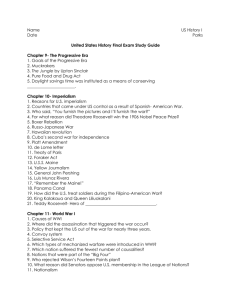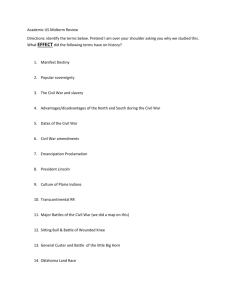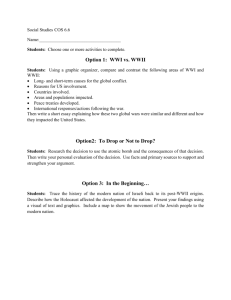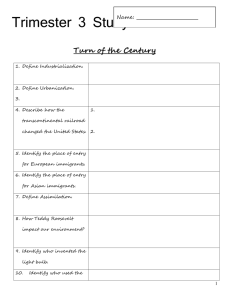AP US HISTORY PERIOD 7 (1890
advertisement
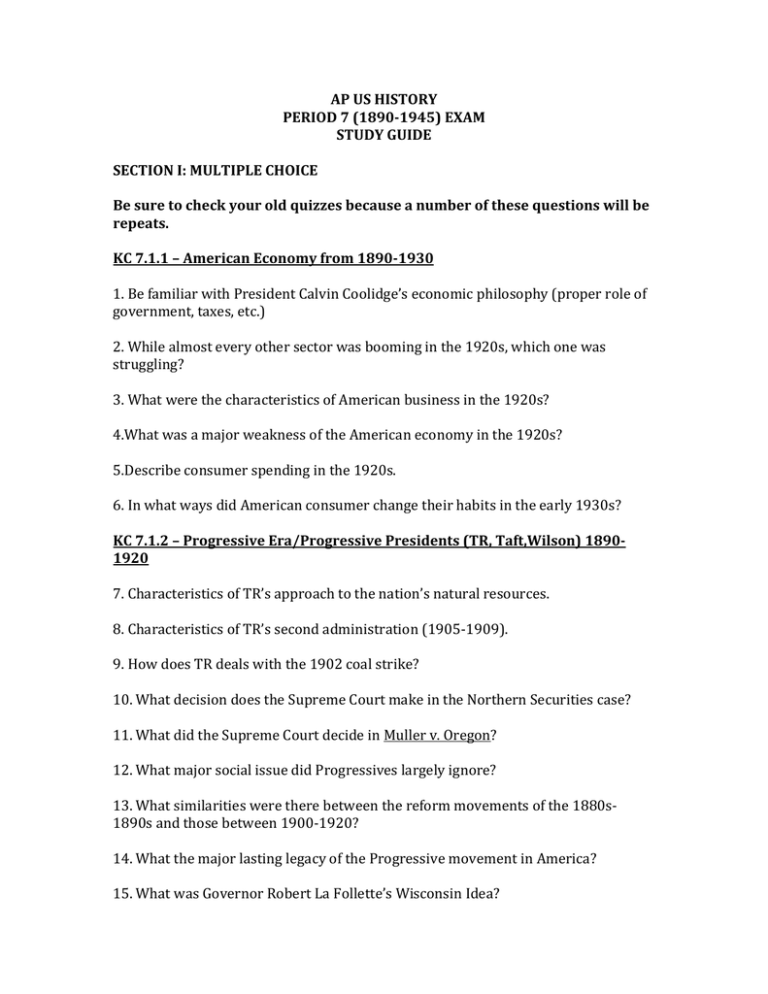
AP US HISTORY PERIOD 7 (1890-1945) EXAM STUDY GUIDE SECTION I: MULTIPLE CHOICE Be sure to check your old quizzes because a number of these questions will be repeats. KC 7.1.1 – American Economy from 1890-1930 1. Be familiar with President Calvin Coolidge’s economic philosophy (proper role of government, taxes, etc.) 2. While almost every other sector was booming in the 1920s, which one was struggling? 3. What were the characteristics of American business in the 1920s? 4.What was a major weakness of the American economy in the 1920s? 5.Describe consumer spending in the 1920s. 6. In what ways did American consumer change their habits in the early 1930s? KC 7.1.2 – Progressive Era/Progressive Presidents (TR, Taft,Wilson) 18901920 7. Characteristics of TR’s approach to the nation’s natural resources. 8. Characteristics of TR’s second administration (1905-1909). 9. How does TR deals with the 1902 coal strike? 10. What decision does the Supreme Court make in the Northern Securities case? 11. What did the Supreme Court decide in Muller v. Oregon? 12. What major social issue did Progressives largely ignore? 13. What similarities were there between the reform movements of the 1880s1890s and those between 1900-1920? 14. What the major lasting legacy of the Progressive movement in America? 15. What was Governor Robert La Follette’s Wisconsin Idea? KC 7.1.3 – The New Deal 1930s 16. DEFINE: 20th Amendment: 17. First action FDR takes after being inaugurated in March, 1933. 18. Of the following, which New Deal “alphabet soup” agency was most accommodating to women? CCC, WPA, CWA, NRA 19. Why was the New Deal so significant? KC 7.2.1-Technology and Culture 1920-30s 20. What role did the automobile play in boosting the American economy in the 1920s? 21. DEFINE: Scopes “monkey trial”: 22. Describe race relations in the years immediately after the war. KC 7.2.2-Cultural Backlash / Minorities 1910s-1920s 23. What was one of the greatest challenges to the US after WWI? 24. Why were there so many militant strikes in 1919? 25.Describe the Red Scare of 1919-1921. 26.What Harding mean by “normalcy.” 27.What did Herbert Hoover do as Secretary of Commerce during the Harding Administration? 28. DEFINE: Teapot Dome Scandal: 29. How was Coolidge different than Harding? In other words, what did Coolidge restore to the White House that had been lacking with Harding? 30. What was a major cause of the 1920s culture wars? 31. Why did the Republicans win in 1928? Be familiar with this election. 32. DEFINE: UNIA KC 7.3.1-Imperialism/Spanish-American War/Foreign Policies of TR,T aft, Wilson – 1890-1914 33. Why did America began expanding its markets into Latin America/Asia in the 1890s? 34. What policies did Admiral Mahan recommend America follow in his book The Influence of Sea Power upon History? 35. DEFINE: Teller Amendment: 36. What strategic value did President McKinley see in the Philippine Islands? 37. What major events took place in Hawaii in the 1890s? 38. What territory does the US gain when it defeats Spain in 1898? 39. DEFINE: Insular Cases (1901) 40. What assumptions influenced TR’s foreign policy? 41. How was TR’s foreign policy in Asia different than TRs? 42. What is the best example of TR’s “Big Stick” policy? 43. DEFINE: Roosevelt Corollary 44. How was Woodrow Wilson’s philosophy of foreign policy different than his predecessors? KC 7.3.2-WWI & years before WWII – 1914-1941 45. How did American trade change between the years 1914 and 1916? 46. What was THE cause of America’s entry into WWI? 47. What more than anything helped the US win WWI? 48. Describe race relations during WWI. 49. How did federal agencies expand the government’s role during WWI? 50. What did the Supreme Court rule in Abrams v. United States? 51. What was the Great Migration? 52. Over what issue related to the League of Nation’s did the Senate fight with Wilson? 53. What were the major characteristics of US foreign policy during the 1920s? 54. Be familiar with the Fascist states in Europe in the 1930s. 55. What helped the Nazi Party rise to prominence and then power? 56. How did the US initially respond to world events in the 1930s? 57. DEFINE: Nye Committee: 58. DEFINE: Neutrality Acts of 1935, 1936, 1937: 59. When does WWII officially start? 60. DEFINE: America First Committee 61. DEFINE: Office of War Information: Lend-Lease: War Refugee Board: Congress of Racial Equality: 62. What were FDR’s “Four Freedoms?” 63. What principles were established by the Atlantic Charter? 64. How did FDR respond to Japan’s invasion of China in 1937? What did he mean by “quarantine?” KC 7.3.3-WWII-1941-1945 65. How did FDR describe the Japanese attack on Pearl Harbor? 66. DEFINE: National War Labor Board: War Powers Act: Office of Price Administration: War Production Board: 67. What was THE most decisive factor contributing to US victory in WWII? 68. DEFINE: “cost-plus” contracts: 69. What made Henry J. Kaiser the “miracle man?” 70. Describe what happened to federal income tax during WWII. 71. Describe discrimination in the armed services during WWII. 72. How did FDR respond to Randolph’s plan to march on Washington? 73. How did the federal government encourage women to sign up for war work? 74. DEFINE: GI Bill: 75. How did the United Mine Worker’s strike end in 1943? 76. Why was Harry S Truman selected as FDR’s VP candidate in 1944? 77. Why did rationing largely work during WWII? 78. What caused racial tensions/riots in 1943? 79. DEFINE: Executive Order 9066: 80. DEFINE: Korematsu v. United States 81. What was the main reason the US participated in WWII? 82. Who were the “Big Three?” 83. What did Joe Stalin put a lot of pressure on the US and Britain to do between 1941 and 1943? 84. What was THE turning point of WWII (European Front)? 85. Winston Churchill suggested that the Allies invade Europe where . . . “soft underbelly?” 86. Why didn’t the US grant asylum to a larger number of Jews in the late 1930s and early 1940s? 87. What was THE main reason Truman decided to use the a-bomb against Japan? SECTION II: SHORT ANSWER 1. You are going to be asked about the role of women as Progressive Era reforms. You should be able to provide specific examples of women and the work that they did during this era. Also, think about why women were so interested in the reforms of this period. 2. You will be presented with two different interpretations of the changes brought with the urbanization of America by the 1920s. You will need to provide specific examples, both positive and negative, of the impact urbanization had on both those already in the cities and those in rural areas (farmer, for example).
